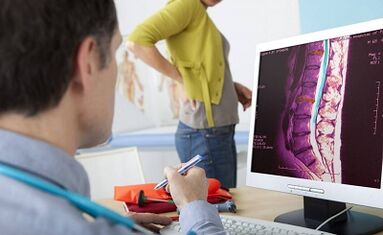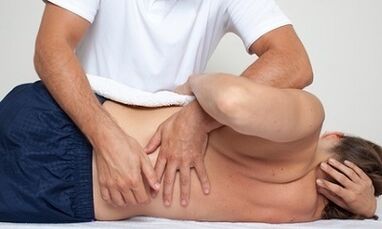Today is the topic: osteochondrosis of the lumbar spine symptoms and treatment, which we will analyze in more detail in our article.Most of the people came across back pain at least once in their lives.Especially applies to the population after the age of 30, the very reason for the occurrence of unpleasant sensations in the lower back.
The causes of osteochondrosis of the lumbar spine
There are only 5 lumbar vertebrae in the human body, they are wide and thick, as they carry the main load.It is their physiological feature and greater mobility that increases the risk of degenerative changes - osteochondrosis.
The most important factor in the formation of disks wear is the constant overload of the department, which is aggravated by a long -term sedentary, hard work, improper posture and many other factors.All these causes provoke muscle overvoltage, impaired tissue blood supply, and cause additional load on the ligaments and joints.
The processes of destruction of hyaline intervertebral cartilage are based on the loss of moisture.A healthy spine can withstand a load of more than 500 kg.In case of loss of hydrophilic properties, elasticity is lost, the disk becomes more flat, the distance between the vertebral bodies decreases.
Several factors in the development of lumbar osteochondrosis are distinguished:
- Increased physical activity and weight lifting.
- Injuries.
- Violations of metabolic processes.
- Hormonal changes.
- Bad habits - irrational nutrition, smoking, alcohol abuse.
- Violation of posture (scoliosis, kyphosis, lordosis, stoop).
- Flat feet.
An important role is played in the formation of degeneration obesity.It not only causes an increase in pressure on the spinal column, but also leads to metabolic disorders, hormonal shifts.
Symptoms and diagnosis
In medicine, the basis of symptoms of osteochondrosis is pain.He has a lot of variations - acute and sharp pain, or, conversely, pulling and pressing.Due to unpleasant sensations, a sick person is often hardly given simple things-climbing from a chair, from a bed, walking.
Often, pain appears in the form of a “shift”-due to an awkward movement, lifting severity.With the aggravation of the processes of destruction of exacerbation of pain, there can occur with coughing and sneezing.
From a forced restriction of activity, the flexibility of the spine is reduced, it becomes more difficult to bend down, shoe.
In addition to vertebral symptoms (which are only to the back), there are a number of extravertibral (spreading beyond the lower back).
It can be:
- Lyubmoichachei-pain along the sciatic nerve (lumbosacral osteochondrosis is most susceptible to this symptom).
- Neurological disorders in the lower extremities - impaired sensitivity, soreness when walking, paresis are possible.
More and more doctors come to the conclusion that osteochondrosis itself does not hurt, all tangible symptoms are a complication of osteochondrosis.So they write in the diagnosis: “Against the background of osteochondrosis ...” Almost 80 percent of pain occurs from muscle inflammation and the formation of trigger points due to which myofascial syndrome occurs.
Diagnostics

Intensive back pain can be caused by many reasons.Therefore, it is important to establish accurate diagnosis, and osteochondrosis of the lumbar spine with different symptoms and treatment is a common concept.For starters, it is necessary to take a number of general tests - biochemistry, blood, urine.They will help to identify inflammatory processes, determine the condition of the body and the level of damage.
As a specialized study, it is recommended to conduct radiography of the spine in two projections - lateral and straight.Clarification of complications is often required, an MRI is used for this.
When there is no way to conduct tomographic studies, myelography will be prescribed - an X -ray examination with a contrast matter, which is introduced into the subarachnoid space of the spinal cord.
Treatment and prevention
Symptoms of osteochondrosis of the lumbar spine require urgent measures in the selection of therapy.During periods of acute pain, complete bed rest is recommended.To maximize the musculoskeletal system.
Important:During the exacerbation period, only drug treatment, massage, physiotherapy and exercise therapy are indicated for the period of relieving pain.
What drugs will help with osteochondrosis:
- Painkillers.
- Nonsteroidal anti -inflammatory drugs (NSAIDs).They should be introduced in courses.
- Ointments with local deviations and anti -inflammatory.
- Musorelaxants - to relieve tension in muscles.
- Supporting therapy - vitamin C as an antioxidant, group B, PP to improve microcirculation, accelerate tissue regeneration.
Carefully:NSAIDs are prescribed together with gastrotrotectors to reduce the negative effect of drugs on the gastrointestinal tract.
If complications arise in the form of a violation of sensitivity, then treatment in the hospital is prescribed.It is possible to use local administration of steroid drugs to relieve inflammation.
After the main treatment, they offer to undergo a course of chondroprotectors that restore the cartilage of the disk.
Manual therapy

The manual therapist acts on the spine with his hands and sets the vertebrae in place - the patient immediately feels relief.
Over the 3-5 sessions of the manual therapist, the distance between the vertebrae increases, the load on them is distributed evenly, blood circulation and nutrition of the damaged area improves.The patient is quickly restored and can return to the usual life.
After the course of the procedures, the manual therapist will recommend a set of exercises to consolidate the result.
Physiotherapy
Physiotherapeutic treatment relieves spasm and enhances blood flow.There are many physiotherapy procedures: electrophoresis, darsonval, laser therapy, phonophoresis, diadynamic currents, magnetic resonance therapy, amplipulse, ultrasonic therapy, vibration massage.It is wonderful to continue physiography at home by budget applications.
- Kuznetsov applicator.
- Pepper patch.
- Banks for osteochondrosis.
Massage
Massage is prescribed during the recovery period only after removing acute pain.It relieves voltage, increases blood flow, significantly improves the patient's condition.The use of warming ointments increases the efficiency of massage.Its action intensifies when visiting the bath, if there are no contraindications.
Resort treatment
Spa treaters, resort show excellent results in the rehabilitation period.Baths with hydrogen sulfide, radon, bromine relax and contribute to restoration.If there is a financial opportunity, it is better to be treated in specialized resorts.
Surgical surgery
It is used only in cases of serious complications, when the rest of the methods did not help: if it is not possible to get rid of pain for more than 4 months or there are signs of severe compression of the nerve roots.A destroyed disk is usually removed (discoctomy).If possible, they try to conduct gentle modern interventions - microsurgical and endoscopic;The rehabilitation period after them is 3-5 times shorter than after a traditional operation.
During periods of the “decline”, special exercises for stretching and removal of trigger points are well copeing with the consequences of osteochondrosis.They weaken the muscle spasm and support the muscle corset in tone.It is important to perform the complex smoothly, avoiding sudden movements.
Therapeutic gymnastics at home
LFK can also be performed at home, having previously conducted several classes with an instructor (to fix the correct execution and not harm yourself).
Physical education is the main method of treatment and prevention of osteochondrosis of the lumbar spine.Exercises strengthen the back muscles, contribute to the correct location of the nerves, an increase in the space between the vertebrae, and the full blood supply to the tissues.
Important.Therapeutic gymnastics cannot be done with acute pain.
The purpose of the exercises is to increase the mobility of the lumbar spine.It is better to start with a small load and a small amplitude of movements.After removing the acute state, lying in bed, you can bend your legs with a simultaneous raising of your head.As it improves, the load is carefully increased.
Simple exercises are useful:
- Standing, hands on the belt, to make inclinations;
- Standing, hands on the belt, to perform rotation of the pelvis;
- “Cat”: in the knee-elbow pose, bend, bend the back, rotate with a basin;
- “Scissors” and “bicycle” lying on the back;
- “Pillage with ropes”: standing, twist the body, hands hanging relaxedly behind the turns of the corps;
- Lie back on the floor, the legs are bent at the knees, perform twisting to the right and left.
Also, do not forget about regular strength exercises to strengthen the muscle corset (squat, push -ups, bar), these two areas of exercises are not divided, no matter what they say.
If the lifestyle is inactive and the profession requires to sit or stand all day, the exercises should be done 3-5 times a day.It is useful to develop the habit of performing exercises every time there is a suitable minute: in the elevator, while the kettle boils or microwave works.
Regular therapeutic gymnastics gives a persistent therapeutic and preventive effect;But even classes from case to case reduces the manifestations of exacerbations.
Folk remedies provide good preventive support during the absence of exacerbation.You can drink decoctions of mint and lemon balm - has a soothing and muscle relaxation effect, contains a large number of vitamins and antioxidants.
Prevention
Learn to listen carefully to the signals of the body, rest in time and reduce the load.
- Follow the posture, especially when you have to sit for a long time.Select furniture in height so that the back is necessarily supported.
- Avoid long static loads (sit, stand, pose in a bent state), take a break every hour - to conduct small physical education or just walk.
- Engage in charging, go to the pool for the formation of a muscle corset, stretching.
- With flat feet, choose the right shoes and special supervisors.
- Correct excess weight.
- Try to lead a healthy lifestyle.
- Use an orthopedic mattress and a pillow.
- Dress the weather, do not hypothermia, use a woolen belt or corset if necessary.
- Walk more: for example, get out of transport to two stops earlier.
- Refuse a bag in favor of a backpack.
- In hard work, use a corset.
- Lift severity smoothly, without jerks and sharp turns (you can get back injury).
Important.Learn to lift severity correctly: you can not bend so that the “lever” forms in the lumbar region.When you raise something heavy, you need to bend your legs, not your back: sit down, take the item and get up with your back.
With age, the development of osteochondrosis of the lumbar spine is inevitable, symptoms can be prevented, treated, greatly simplified, with a careful attitude to yourself not to reduce the quality of life.
Take care of yourself and your spine!

























































































